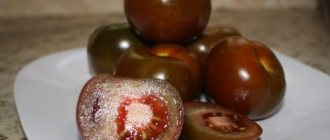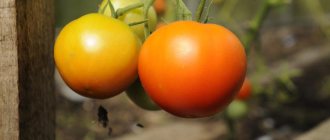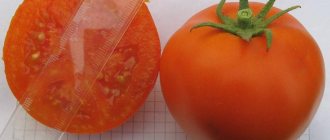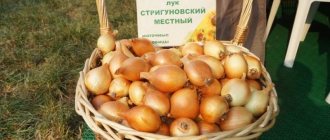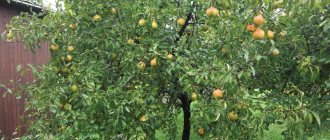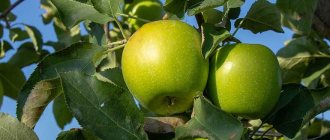Gardeners are trying to choose the best crops for the plot. Each variety must meet their requirements and desires. Many people want to find something universal, reliable, proven. This can be called the Tiger tomato. Farmers claim that such tomato plants can develop well in different conditions, be it open or closed ground.
The attention of many is drawn to this variety because of its interesting coloring. Looking at the external characteristics of tomatoes, you can guess why they were called Tiger. But the unique “appearance” of vegetables is not the only thing that makes this type of crop so popular.
Description and characteristics of the variety
The Tiger tomato belongs to the group of medium-sized determinants. Its shoots grow quite strong and are well leafy. Features of the bushes:
- shoot height 1.5 m;
- moderate branching, semi-spreading;
- dark green leaves;
- simple inflorescences;
- fruitful clusters 7-9;
- 6-8 tomatoes ripen on the bunches.
The yield of the crop begins in the average period - 115-125 days from germination.
Description of tomatoes:
- average weight 50-70 g;
- round, neat shape;
- dimensions are approximately the same;
- the coloring resembles the fur of a tiger – there are bright golden stripes on a red background;
- the pulp is tender, fleshy;
- seed chambers 3-4.
The taste is pleasant - it harmoniously combines sourness and sweetness. Tomatoes have a universal purpose.
Reviews
Irina Sergeevna
I have been planting Tiger tomato for many years. My children like small striped tomatoes. I grow it from my own seeds, sometimes I renew it and buy it in the store. I sow and grow the seeds on the windowsill, and then transplant them into open ground. The variety ripens on site, although some large varieties do not always ripen. Resistant to late blight.
Victoria
I studied the description of the Tiger variety, became interested in the multi-colored color of the fruit, and decided to try to grow it. Tomato bushes are tall. Tomatoes with a sweetish taste. The yield is excellent, almost a bucket per bush. When pickled, ripe fruits crack, but the green-brown ones look beautiful. Keeping quality is average.
Features of cultivation and storage
The seedlings are transplanted upon reaching 55-60 days. The bushes should already have 5-6 leaves and 1 cluster of flowers.
The best predecessors for high yields are the following crops:
- carrot;
- pumpkin;
- zucchini;
- greenery;
- salads.
To increase the fertility of the bed, compost and phosphorus-potassium mixtures are added.
The bushes are placed at a distance of 50-60 cm. As they grow, they are formed into 2-3 shoots. They breed every 10-12 days.
Advantages and disadvantages of tomato
Many reviews about the taste and cultivation characteristics characterize the variety well both in closed and open ground conditions.
Advantages attractive when growing:
- original appearance of tomatoes;
- good yield;
- sweetish, juicy taste;
- preservation of presentation during ripening, storage, transportation;
- different ways to eat fresh and canned.
Among the disadvantages is the high growth of shoots that need to be pinched and tied up. But in general, the characteristics of the variety allow you to get a generous harvest in the greenhouse and outdoors.
Main characteristics
This tomato variety is characterized by good productivity, but is susceptible to growing conditions - if the weather is hot, dry, and watering is irregular, the bushes begin to shed flowers and ovaries, which negatively affects the yield.
Tomato Amur Tiger - harvest photo
Yield indicators of tomato Amur Tiger
When growing bushes in 1-2 shoots, the yield of the Amur Tiger tomato will be good - up to 12 kg of beautiful striped tomatoes are harvested from each square of area.
Area of application of fruits
Harvested tomatoes are used for salad purposes; they are very tasty in salads and appetizers.
. Large tomatoes are used to make lecho, tomato paste and ketchup. And smaller fruits are suitable for whole-fruit canning. Moreover, it should be noted that the fruits do not crack even during heat treatment, and remain striped in jars.
Diseases and pests
The Amur Tiger tomato is highly resistant to most diseases characteristic of other tomato varieties.
Of the harmful insects, this tomato variety can be damaged by aphids
and
spider mites
. You can fight them with folk remedies - spray the bushes with infusion of red pepper or sprinkle with tobacco dust.
If folk remedies practically do not help cope with a large number of pests, then you have to use solutions of insecticidal preparations.
Interesting article: Varieties of unusual tomatoes with descriptions and photos
The main advantages of the variety
The main positive qualities of the Amur Tiger tomato variety include:
- early fruit ripening;
- large fruit;
- good taste and appearance;
- high productivity;
- during transportation, the fruits do not burst or flow;
- resistance of Amur Tiger bushes to major tomato diseases;
- the ability to collect seed material for further planting;
- the versatility of the collected fruits.
Among the disadvantages of the variety, it should be noted:
- tomato depends on weather conditions, and is also picky about growing conditions - in case of stressful situations, the bushes shed their ovaries;
- short shelf life of collected fruits.
Photo of Amur Tiger tomato on a bush
Tomato Siberian Tiger: description, photos, reviews
Spring is ahead again and gardeners are dreaming of new varieties of tomatoes that will be grown on their plots. There are a great many varieties and hybrids on the market; choosing is not so easy. That is why descriptions and characteristics of interesting tomatoes are needed.
One of the amazing varieties is the Siberian Tiger tomato. This is a product of selection by scientists from the United States of America. The author is Mark McCaslin. He called his brainchild Siberian Tiger.
Description of the variety
The Blue and King of Beauty varieties were chosen as the parents of the new Siberian Tiger tomato. In the southern regions, the tomato produces good results in open ground, but in the middle zone it is recommended to grow it in greenhouses.
Features of the bush
The exotic pink tomato Siberian Tiger is an indeterminate variety. The plant is mid-season, technical maturity occurs 110-120 days after germination.
Tomato bushes are tall, up to 1.5 meters (in a greenhouse), and cannot be grown without support and tying. To get a decent harvest, you need to pruning and removing excess leaves. A bush of 1-2 stems is formed.
The leaves of the American tomato variety are rich green. They are long and have medium foliage. Peduncles are powerful, with a large number of ovaries (from 4 to 6). About 6-7 tassels of tomatoes are formed on one stem.
Fruit
The shape of the tomato does not always correspond to the description on the bag. The thing is that this tomato is still being improved.
Attention! In addition, different agricultural companies produce Siberian Tiger tomato seeds, perhaps the form differs for this reason.
That’s why gardeners write in reviews that tomatoes are semicircular or resemble a ball. On American variety tomatoes, regardless of the shape of the fruit, ribbing is observed.
The Siberian Tiger tomato variety has dense flesh and is fleshy, but the skin is thin. Unripe fruits are light green in color with emerging stripes. In technical ripeness, you can’t take your eyes off this tomato variety. This exotic fruit of American origin will not leave anyone indifferent.
Tomatoes of the Siberian Tiger variety are distinguished by their bright purple-pink color. The shoulders of the stalk become violet-blue in color, and there are also stripes reminiscent of the colors of a tiger.
Attention! Tomatoes that are well illuminated by the sun acquire a particularly bright color.
The weight of the fruit on the first cluster is 300 grams and slightly higher. The remaining inflorescences produce tasty, sweet tomatoes with a fruity aroma, weighing about 150 grams.
The fruits of this variety are multi-chambered and sugary when cut. The flesh is deep red. Tomatoes have a lot of seeds and are medium in size.
Characteristics of the variety
Based on the description of the Siberian Tiger tomato, we will find out its advantages and disadvantages.
pros
- Exotic appearance.
- Excellent and unusual taste properties.
- Possibility of growing tomatoes in open and protected ground.
- Not a bad yield, considering the weight of the fruit and the number of formed inflorescences and ovaries.
- This variety of tomatoes does not crack on the bushes if watering is not too abundant. They hold up well and do not fall off, even when overripe.
- Siberian Tiger tomatoes are universally used.
An excellent raw material for sauces, tomato juice, making lecho, ketchup and salads for the winter. - The transportability of the variety is average; due to the thin skin, the fruits require special placement in boxes.
Important! The originators of the tomato claim that the Siberian Tiger is resistant to many diseases that affect other nightshade crops.
As you can see, there are many advantages. Let's look at the disadvantages:
- A tall determinate plant must be limited in growth by pinching the main stem.
- Tomato varieties need to be formed into only one or two stems so as not to overload the plants, therefore, pinching is indispensable. Tomatoes need to be tied not only the stems, but also the bunches, as shown in the photo.
- The variety is not suitable for canning whole fruits due to its thin skin.
- In southern conditions, all brushes ripen even in open ground. In the risky farming zone, the Siberian Tiger variety of tomatoes can only be grown in a greenhouse.
As you can see, tomato has both advantages and disadvantages. But without starting to grow a plant, it is difficult to judge it. Therefore, we recommend that you try to grow an exotic plant, and then send us your feedback about the Siberian Tiger variety tomatoes, as well as add to the description and characteristics.
Interesting varieties of tomatoes:
Agricultural technology varieties
As indicated in the characteristics and description of the variety, the Siberian Tiger tomato can be grown in any soil, depending on the climatic conditions of the region.
Preparing seedlings
- Tomato seeds of this variety are planted in prepared soil in containers convenient for every gardener. The soil can be purchased at the store (it is completely balanced) or you can prepare it yourself by taking equal parts of soil from the garden bed, compost or humus. To improve the soil structure, add a little sand, and to combat blackleg, add wood ash.
- The soil and container must be disinfected. As a rule, boiling water with potassium permanganate added to it is used. The pink solution is poured onto the ground and covered with a thick cloth to improve the effect of the treatment.
- Tomato seeds also need to be prepared.
They are first poured into salt water to select frail and immature specimens (they will float to the top). Then they are washed in warm water and placed in a pink solution of potassium permanganate for about 15 minutes. Wash again and dry to a free-flowing state. It is not recommended to soak and germinate seeds of the Siberian Tiger tomato variety. - Dry seeds are placed in sowing containers to a depth of no more than 1.5 cm (ideally 8-9 mm) in moist soil.
Cover the top of the container with a piece of cellophane to speed up germination. Before germination, the box is placed in a warm, lighted window. Thanks to the greenhouse effect, tomato seeds germinate within 4-5 days. The film is removed and the temperature is reduced slightly so that the seedlings do not stretch. To save space on the windowsill, seeds can be grown in a snail.And the video below will help those gardeners who are using this method of planting tomatoes for the first time to cope with the work:
- When two or three true leaves appear, pick them into separate cups with a volume of at least 500 ml. In smaller containers, plants will feel uncomfortable, which will negatively affect the seedlings.
- Before planting in a permanent place, glasses with Siberian Tiger tomatoes are taken out into the fresh air for hardening. Tomatoes that are ready for planting will have a bluish tint to their stems.
Planting and care in the ground
The land for tomatoes is prepared in the fall. It is fertilized and dug up. If for some reason the work was not completed, then this can be done in the spring.
After preparing the holes, each is spilled with a pink solution of potassium permanganate (boiling water), and a handful of wood ash is added.
The distance between plants is at least 50 cm, because only 4 tomatoes are planted per square meter. The seedlings should not be deeply buried, otherwise the growing season will be prolonged. The fruits will ripen about two weeks later.
Attention! Thickened plantings of tomatoes lead to crop loss, since the plants will not have enough light and air.
Immediately after planting, the seedlings are watered and the soil is mulched. Be sure to tear off the lower leaves and stepsons before the first fork. Form a bush in a greenhouse with one or two stems. In open ground you can leave 2-3. Subsequently, all the stepsons are removed and the leaves under the clusters are pinched. This will provide light access and facilitate air circulation.
Further care for Siberian Tiger tomatoes comes down to traditional actions:
- watering, loosening, weeding;
- feeding tomatoes;
- preventive measures against diseases.
Siberian Tiger tomatoes are recommended to be fed with organic fertilizers.
When the bush grows to the ceiling of the greenhouse, the stems are pinched. This operation allows you to redistribute nutrients that will begin to work on the formation and ripening of the crop.
Gardeners' opinion
Stepan, 31 years old, Bratsk
I am a big fan of experiments, so every year I grow different varieties and hybrids of tomatoes in my greenhouse. I bought Siberian Tiger seeds last year. I was not satisfied with the germination of the seeds, only 50%. But I liked the variety itself for its unusual taste and amazing fruit colors. The tomatoes have grown up to one and a half meters, the fruits are heavy, from 150 to 250 grams.
Moreover, the harvest this summer was no worse. Unfortunately, we had to buy seeds again. We made salads from ripe tomatoes. The result was a truly exotic dish with yellow, red, inky purple and orange pieces. The brown tomatoes picked at the beginning of September were all ripe and had lost neither shape nor taste. If I come across tiger seeds in winter, I will definitely buy them.
Sergey, 61 years old, Ekaterinburg
Among the large number of tomatoes that my wife and I grow in a polycarbonate greenhouse, I liked the Siberian Tiger the most for its unusual fruity and sweet taste. The harvest, of course, cannot be called too rich, but 2 kg per bush is also not bad. What I liked most was the tomato juice made from the fruits of the variety: thick, with a rich taste. We've prepared some for the winter so we can give our grandchildren some vitamins.
Source: https://fermilon.ru/sad-i-ogorod/ovoshhi/tomat-rozovyj-sibirskij-tigr.html
Care
Thorough irrigation is carried out only after transplantation, then you should adhere to the drip irrigation method, uniform. Water is directed under low pressure under the stem so that it reaches the root system. Watering is preferably done in the morning, which allows moisture to be absorbed until night. This prevents the tomato bushes from experiencing a stress response to possible freezing in moist, cool soil.
In terms of fertilizing, it is enough to alternate minerals and organic matter. But you should not ignore symptoms indicating a deficiency of certain compounds. Sometimes it is necessary to focus on magnesium and calcium in order to achieve balanced development of the plant and avoid diseases and reduced ovary production. Gardeners should not forget about mulch, which may be needed in cold or hot weather.
Fruit
They are very beautiful! In the photo I saw them completely striped, really looking like the skin of a tiger or a St. George’s ribbon. I didn’t grow any of these, but there was a pleasant play of dark red, pinkish-scarlet and purple shades.
Tomatoes are ribbed, roundish in shape. The skin is quite thin and I like it - I enjoyed cutting them into salads. And the family devoured them, too, with pleasure.
These tomatoes have a fairly high acid content, so I was happy to make vegetable kebabs from them, add them to meat, and cook tomato sauce. I made canned food. Quite!
What does "correct" mean? I'll explain now:
- Don’t get too carried away with breaking off the leaves: the leaves provide the fruits with everything useful and nutritious, so don’t harm your tomatoes with excessive zeal.
- Don't forget to ventilate the greenhouse. Even such heat-loving “Americans” do not like excessive heat - it should not be more than 32 degrees.
- Be careful with fresh manure - instead of a large harvest of fruits, you will get a huge harvest of leaves and shoots. But it’s good if you collect a kilogram of fruit.
- The best “predecessors” of the variety are legumes, cucumbers, cabbage, and carrots.
- Don't forget to stepchild! Otherwise, you will have a lush jungle with stunted fruits: everything will turn into greenery.
- Do not flood the bushes - this variety does not like excessive moisture.
- A little secret: when all the fruits on the first cluster are ripe, cut off all the leaves above it. Do this throughout the entire ripening period. But do not tear more than 4 leaves on one bush per week.
